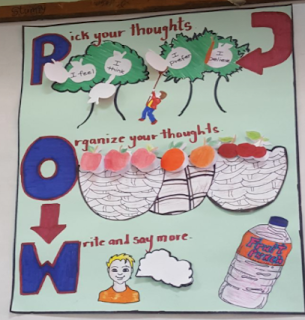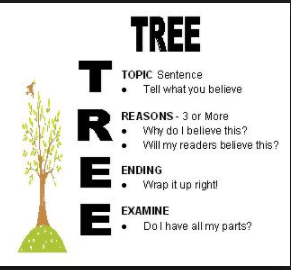The focus of last week’s sessions was on Expository Writing. Although we already knew about this genre of writing, we learnt much more in the two sessions. We know that the purpose of expository writing is to be informative as it seeks to provide or explain information to readers. In the first session, we learnt about some of the elements of expository writing. We discovered that this genre relies heavily on research and cited material as well as what experts say. Although we associated expert information, research and cited materials with expository writing, we did not realize that they are the basis of the genre.
One of the things that was reinforced in last week’s sessions was that expository writing must be objective and should not include personal pronouns. When we reflected on expository pieces that we wrote in the past, we realized that we used a few of these personal pronouns, specifically ‘you’ and ‘your’.

Moreover, we learnt about the expository text structures. We discovered that introducing these text structures to students at the primary level will prevent them from struggling with the structures at the secondary level and onward. In previous ‘Language-based courses’, we learnt about the purpose of expository writing, its text structures and how to create an expository piece for academic purposes. However, during this lecture, we learnt how to teach expository writing to students.
While we were learning about how to teach expository writing, there were a few things that caught our attention. Firstly, it was stated that we should teach the elements of expository writing to students and explain to them that there are no characters, setting, plot or a problem in the genre. Similarly, we were told that we should let the students compare the fiction and non-fiction pieces as they would clearly see the features of each genre. While explaining this point the lecturer showed an example of a narrative and an expository piece in the Keskidee Reader 2 and modeled what we should explain to the students. This was one aspect of the class that we really liked.
Moreover, we learnt that utilizing strategies such as POW, TREE, and TAP will help our students in their writing. We think that these strategies are very useful for us and students because they simply outline what the students should do when writing expository pieces.
 |
| Chart showing the POW writing strategy |
 |
| Image showing the TREE writing strategy |
It is common knowledge that problems will be encountered in the classroom during the teaching and learning process. We learnt that one of the problems that we will encounter when teaching expository writing is plagiarism. We understand now that no matter the age group or grade level, students will plagiarize and we have to teach them that this is a wrong practice. When we reflected on this piece of information, we realized that this is the reason why it is important to know your students’ voice. When you know your students’ style of writing, you are aware of their abilities, word choice, type(s) of sentences frequently used and this allows you to detect when a student plagiarizes.
 During last week’s lecture there were some aspects of the class that we really enjoyed. At the beginning of the class, we were required to display our charts that showed the link between the stages of the writing process and the six plus one traits of writing. Although all the charts presented were very creative and accomplished the intended task, our favourite charts were the ‘Six trait train’ and ‘Linking the writing process and the writing traits with Noella’.
During last week’s lecture there were some aspects of the class that we really enjoyed. At the beginning of the class, we were required to display our charts that showed the link between the stages of the writing process and the six plus one traits of writing. Although all the charts presented were very creative and accomplished the intended task, our favourite charts were the ‘Six trait train’ and ‘Linking the writing process and the writing traits with Noella’.
Secondly, we liked that the lecturer retaught the components of Language Arts Literacy block lesson plan. Although it was not a part of the lecture, the lecturer explained each component of the block, what they focus on and how we would teach expository writing using the Literacy Block. This was very helpful as prior to this lesson we did not know the concepts that can be taught at the Word Level when utilizing the Literacy Block to teach writing. We know now that we can teach subtopics such as the ‘elements or features of expository writing’ or ‘connectives’ when teaching expository writing.
Overall, last week’s sessions were informative and interesting. Despite this, there are two suggestions that we have for future lectures. Firstly, we suggest that the lecturer reads models of different pieces related to the genre of writing we will be focusing on for the lecture. This will provide us with an insight on what the students are exposed to at the primary level.
Our final suggestion is the use of exit or admit slips. Instead of writing the responses, we can provide our responses orally. By using one of these strategies, the lecturer will know whether we understand the information or not and the extent of our understanding. Also, exit and admit slips help us to reflect on the day’s learning and previous day’s learning respectively. We believe that the use of these slips will help us to learn better.

I enjoy reading your blog post this week. I like the fact that you analyse what was said and done in class to determine where they would be applicable as prospective teachers. Certainly, I second you on the point that stated, knowing our students voice we would know if they are victims of plagiarism. In addition, I liked the fact that you added some examples (charts) of the strategies into your post, so your audience would have an idea of what you are talking about. Moreover, I agree with both of your suggestions and hope that the lecturer takes them into consideration.
ReplyDeleteHowever, I would have appreciated if you had stated why that chart from the presentations we did in class was your favorite to provide some form of feedback.
Continue the good work in your blog
Regards,
Rhea Lewis
Rekeisha Lewis
Monica Lewis
Janet Charles-Johnson